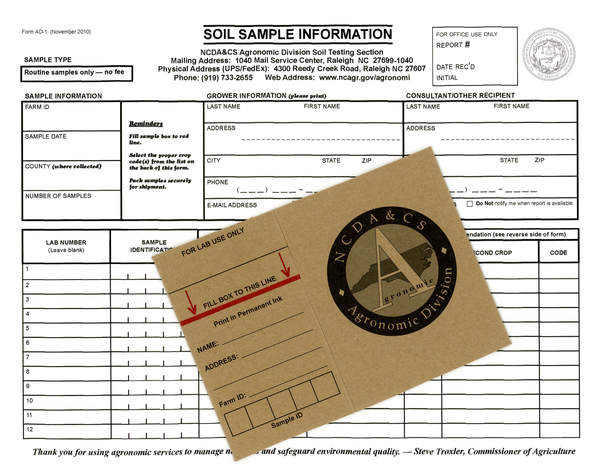Soil Sampling
go.ncsu.edu/readext?965454
en Español / em Português
El inglés es el idioma de control de esta página. En la medida en que haya algún conflicto entre la traducción al inglés y la traducción, el inglés prevalece.
Al hacer clic en el enlace de traducción se activa un servicio de traducción gratuito para convertir la página al español. Al igual que con cualquier traducción por Internet, la conversión no es sensible al contexto y puede que no traduzca el texto en su significado original. NC State Extension no garantiza la exactitud del texto traducido. Por favor, tenga en cuenta que algunas aplicaciones y/o servicios pueden no funcionar como se espera cuando se traducen.
Português
Inglês é o idioma de controle desta página. Na medida que haja algum conflito entre o texto original em Inglês e a tradução, o Inglês prevalece.
Ao clicar no link de tradução, um serviço gratuito de tradução será ativado para converter a página para o Português. Como em qualquer tradução pela internet, a conversão não é sensivel ao contexto e pode não ocorrer a tradução para o significado orginal. O serviço de Extensão da Carolina do Norte (NC State Extension) não garante a exatidão do texto traduzido. Por favor, observe que algumas funções ou serviços podem não funcionar como esperado após a tradução.
English
English is the controlling language of this page. To the extent there is any conflict between the English text and the translation, English controls.
Clicking on the translation link activates a free translation service to convert the page to Spanish. As with any Internet translation, the conversion is not context-sensitive and may not translate the text to its original meaning. NC State Extension does not guarantee the accuracy of the translated text. Please note that some applications and/or services may not function as expected when translated.
Collapse ▲There are many tools that home gardeners use that are not much different from the farmers except for scale and cost. For example, a home gardener may till their garden site with a powered tiller that they walk behind. This machine may cost anywhere from $400 to more than a $1000. A local farmer will hitch their 200 plus horsepower tractor to a tillage implement that may have a combined cost of more of than $300,000. There is a big difference in scale between the home gardener’s machine and the farmer’s, but they achieve the same goal, tilling the land in preparation for planting. Also, there is a difference in the amount of work that can be achieved between the two machines. The home gardener may run the tiller on a few hundredths of an acre in a day and the farmer can till more than a hundred acres in the same time. But, there is one tool that both the home gardener and farmer can or do use that is quite beneficial and I’ll tell you about that in a minute.
Soil is a living, dynamic resource that supports plant life. It is made up of different size mineral particles (sand, silt, and clay), organic matter, and numerous species of living organisms. Soil has biological, chemical, and physical properties that are always changing. Both the home gardener and farmer depend on the soil to grow their crops/plants. One of the foundational practices to help insure that both the home gardener and farmer have productive plants/crops is to properly feed their plants by providing the nutrients needed. Many of those nutrients are present in the soil as organic matter (remains of living organisms) or is provided by the farmer/home gardener from various sources.
My soil science professor at North Carolina State University told us that soil had more chemical reactions taking place than a modern chemical factory. Many of these chemical reactions impact the availability of nutrients in the soil that plants/crops need.
How can the home gardener as well as the farmer know whether their plants/crops have the proper amount of nutrients? The answer is soil testing. Soil testing is a service provided to any citizen in the state by the NC Department of Agriculture and Consumer Services Agronomic Services. A standard soil test provides a wealth of information including whether or not you need lime and/or various plant nutrients. If you would like to learn how to take a proper soil sample to have it tested at the NC Department of Agriculture and Consumer Services Agronomic Services lab, use the following link Taking a soil sample
NCDA&CS provides this service free of charge except during what is called “peak times”, which is December 1, 2023 to March 31, 2024. The N.C. Cooperative Extension, Pasquotank County Center (252-338-3954) has the materials needed to submit soil samples as well as other information about the service and can assist you with interpretation of the results.




